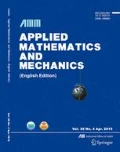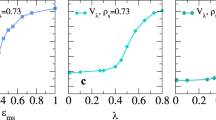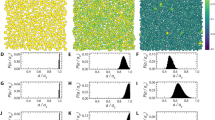Abstract
The mechanics and swelling kinetics of polymeric microgels are simulated using a mesoscale computational model based on dissipative particle dynamics. Microgels are represented by a random elastic network submerged in an explicit viscous solvent. The model is used to probe the effect of different solvent conditions on the bulk modulus of the microgels. Comparison of the simulation results through the volume phase transition reveals favorable agreement with Flory-Rehner’s theory for polymeric gels. The model is also used to examine the microgel swelling kinetics, and is found to be in good agreement with Tanaka’s theory for spherical gels. The simulations show that, during the swelling process, the microgel maintains a nearly homogeneous structure, whereas deswelling is characterized by the formation of chain bundles and network coarsening.
Similar content being viewed by others
References
Hoffman, A. S. Hydrogels for biomedical applications. Advanced Drug Delivery Reviews, 64, 18–23 (2012)
Chaudhuri, O., Gu, L., Klumpers, D., Darnell, M., Bencherif, S. A., Weaver, J. C., Huebsch, N., Lee, H. P., Lippens, E., and Duda, G. N. Hydrogels with tunable stress relaxation regulate stem cell fate and activity. Nature Materials, 15, 326 (2016)
Shin, S. R., Bae, H., Cha, J. M., Mun, J. Y., Chen, Y. C., Tekin, H., Shin, H., Farshchi, S., Dokmeci, M. R., and Tang, S. Carbon nanotube reinforced hybrid microgels as scaffold materials for cell encapsulation. ACS Nano, 6, 362–372 (2011)
Kim, M. Y. and Kim, J. Y. Chitosan microgels embedded with catalase nanozyme-loaded mesocellular silica foam for glucose-responsive drug delivery. ACS Biomaterials Science and Engineering, 3, 572–578 (2017)
Utech, S., Prodanovic, R., Mao, A. S., Ostafe, R., Mooney, D. J., and Weitz, D. A. Microfluidic generation of monodisperse, structurally homogeneous alginate microgels for cell encapsulation and 3D cell culture. Advanced Healthcare Materials, 4, 1628–1633 (2015)
Hardin, J. O., Fernandez-Nieves, A., Martinez, C. J., and Milam, V. T. Altering colloidal surface functionalization using DNA encapsulated inside monodisperse gelatin microsphere templates. Langmuir, 29, 5534–5539 (2013)
Brown, A. C., Stabenfeldt, S. E., Ahn, B., Hannan, R. T., Dhada, K. S., Herman, E. S., Stefanelli, V., Guzzetta, N., Alexeev, A., Lam, W. A., Lyon, L. A., and Barker, T. H. Ultrasoft microgels displaying emergent platelet-like behaviours. Nature Materials, 13, 1108–1114 (2014)
Douglas, A. M., Fragkopoulos, A. A., Gaines, M. K., Lyon, L. A., Fernandez-Nieves, A., and Barker, T. H. Dynamic assembly of ultrasoft colloidal networks enables cell invasion within restrictive fibrillar polymers. Proceedings of the National Academy of Sciences, 114, 885–890 (2017)
Wu, S. H., Duan, B., Qin, X. H., and Butcher, J. T. Nanofiber-structured hydrogel yarns with pH-response capacity and cardiomyocyte-drivability for bio-microactuator application. Acta Biomaterialia, 60, 144–153 (2017)
Ye, C. H., Nikolov, S. V., Calabrese, R., Dindar, A., Alexeev, A., Kippelen, B., Kaplan, D. L., and Tsukruk, V. V. Self-(un)rolling biopolymer microstructures: rings, tubules, and helical tubules from the same material. Angewandte Chemie International Edition, 54, 8490–8493 (2015)
Ye, C. H., Nikolov, S. V., Geryak, R. D., Calabrese, R., Ankner, J. F., Alexeev, A., Kaplan, D. L., and Tsukruk, V. V. Bimorph silk microsheets with programmable actuating behavior: experimental analysis and computer simulations. ACS Applied Materials and Interfaces, 8, 17694–17706 (2016)
Vikram, S. A. and Sitti, M. Targeted drug delivery and imaging using mobile milli/microrobots: a promising future towards theranostic pharmaceutical design. Current Pharmaceutical Design, 22, 1418–1428 (2016)
Nikolov, S. V., Yeh, P. D., and Alexeev, A. Self-propelled microswimmer actuated by stimuli- sensitive bilayered hydrogel. ACS Macro Letters, 4, 84–88 (2015)
Masoud, H., Bingham, B. I., and Alexeev, A. Designing maneuverable micro-swimmers actuated by responsive gel. Soft Matter, 8, 8944–8951 (2012)
Du, H. B. and Qian, X. H. Molecular dynamics simulations of PNIPAM-co-PEGMA copolymer hydrophilic to hydrophobic transition in NaCl solution. Journal of Polymer Science Part B: Polymer Physics, 49, 1112–1122 (2011)
Kang, M. K. and Huang, R. A variational approach and finite element implementation for swelling of polymeric hydrogels under geometric constraints. Journal of Applied Mechanics, 77, 061004 (2010)
Mills, Z. G., Mao, W. B., and Alexeev, A. Mesoscale modeling: solving complex flows in biology and biotechnology. Trends in Biotechnology, 31, 426–434 (2013)
Yeh, P. D. and Alexeev, A. Mesoscale modelling of environmentally responsive hydrogels: emerg- ing applications. Chemical Communications, 51, 10083–10095 (2015)
Espanol, P. and Warren, P. Perspective: dissipative particle dynamics. The Journal of Chemical Physics, 146, 150901 (2017)
Groot, R. D. and Warren, P. B. Dissipative particle dynamics: bridging the gap between atomistic and mesoscopic simulation. Journal of Chemical Physics, 107, 4423–4435 (1997)
Hoogerbrugge, P. J. and Koelman, J. M. V. A. Simulating microscopic hydrodynamic phenomena with dissipative particle dynamics. Europhysics Letters, 19, 155–160 (1992)
Espanol, P. and Warren, P. Statistical-mechanics of dissipative particle dynamics. Europhysics Letters, 30, 191–196 (1995)
Glotzer, S. C. and Paul, W. Molecular and mesoscale simulation methods for polymer materials. Annual Review of Materials Research, 32, 401–436 (2002)
Groot, R. D. and Rabone, K. L. Mesoscopic simulation of cell membrane damage, morphology change and rupture by nonionic surfactants. Biophysical Journal, 81, 725–736 (2001)
Chen, S., Phan-Thien, N., Fan, X. J., and Khoo, B. C. Dissipative particle dynamics simulation of polymer drops in a periodic shear flow. Journal of Non-Newtonian Fluid Mechanics, 118, 65–81 (2004)
Fedosov, D. A., Karniadakis, G. E., and Caswell, B. Dissipative particle dynamics simulation of depletion layer and polymer migration in micro and nanochannels for dilute polymer solutions. Journal of Chemical Physics, 128, 144903 (2008)
Spenley, N. A. Scaling laws for polymers in dissipative particle dynamics. Europhysics Letters, 49, 534–540 (2000)
Ripoll, M., Ernst, M. H., and Espanol, P. Large scale and mesoscopic hydrodynamics for dissipative particle dynamics. Journal of Chemical Physics, 115, 7271–7284 (2001)
Lee, M. T., Vishnyakov, A. N., and Alexander, V. Modeling proton dissociation and transfer using dissipative particle dynamics simulation. Journal of Chemical Theory and Computation, 11, 4395–4403 (2015)
Li, N. K., Kuang, H. H., Fuss, W. H., and Yingling, Y. G. Salt responsive morphologies of ssDNA-based triblock polyelectrolytes in semi-dilute regime: effect of volume fractions and polyelectrolyte length. Macromolecular Rapid Communications, 38, 1700422 (2017)
Groot, R. D. Electrostatic interactions in dissipative particle dynamics-simulation of polyelectrolytes and anionic surfactants. Journal of Chemical Physics, 118, 11265–11277 (2003)
Ibergay, C., Malfreyt, P., and Tildesley, D. J. Electrostatic interactions in dissipative particle dynamics: toward a mesoscale modeling of the polyelectrolyte brushes. Journal of Chemical Theory and Computation, 5, 3245–3259 (2009)
Boek, E. S., Coveney, P. V., Lekkerkerker, H. N. W., and van der Schoot, P. Simulating the rheology of dense colloidal suspensions using dissipative particle dynamics. Physical Review E, 55, 3124–3133 (1997)
Symeonidis, V., Karniadakis, G. E., and Caswell, B. Dissipative particle dynamics simulations of polymer chains: scaling laws and shearing response compared to DNA experiments. Physical Review Letters, 95, 076001 (2005)
Ganzenmuller, G. C., Hiermaier, S., and Steinhauser, M. O. Shock-wave induced damage in lipid bilayers: a dissipative particle dynamics simulation study. Soft Matter, 7, 4307–4317 (2011)
Chu, X. L., Aydin, F., and Meenakshi, D. Modeling interactions between multicomponent vesicles and antimicrobial peptide-inspired nanoparticles. ACS Nano, 10, 7351–7361 (2016)
Pivkin, I. V., Peng, Z. L., Karniadakis, G. E., Buffet, P. A., Dao, M., and Suresh, S. A Biomechanics of red blood cells in human spleen and consequences for physiology and disease. Proceedings of the National Academy of Sciences of the United States of America, 114, E4521 (2017)
Masoud, H. and Alexeev, A. Permeability and diffusion through mechanically deformed random polymer networks. Macromolecules, 43, 10117–10122 (2010)
Masoud, H. and Alexeev, A. Controlled release of nanoparticles and macromolecules from re- sponsive microgel capsules. ACS Nano, 6, 212–219 (2012)
Sirk, T. W., Slizoberg, Y. R., Brennan, J. K., Lisal, M., and Andzelm, J. W. An enhanced entangled polymer model for dissipative particle dynamics. Journal of Chemical Physics, 136, 134903 (2012)
Tarjan, R. Depth-first search and linear graph algorithms. SIAM Journal on Computing, 1, 146–160 (1972)
Pelaez-Fernandez, M., Souslov, A., Lyon, L. A., Goldbart, P. M., and Fernandez-Nieves, A. Impact of single-particle compressibility on the fluid-solid phase transition for ionic microgel suspensions. Physical Review Letters, 114, 098303 (2015)
Senff, H. and Richtering, W. Influence of cross-link density on rheological properties of temperature-sensitive microgel suspensions. Colloid and Polymer Science, 278, 830–840 (2000)
Fernandez-Nieves, A., Wyss, H., Mattsson, J., and Weitz, D. A. Microgel Suspensions: Fundamentals and Applications, John Wiley and Sons, Singapore (2011)
De Gennes, P. G. Scaling Concepts in Polymer Physics, Cornell University Press, New York (1979)
Annabi, N., Nichol, J. W., Zhong, X., Ji, C. D., Koshy, S., Khademhosseini, A., and Dehghani, F. Controlling the porosity and microarchitecture of hydrogels for tissue engineering. Tissue Engineering Part B: Reviews, 16, 371–383 (2010)
Stukowski, A. Visualization and analysis of atomistic simulation data with OVITO—the open visualization tool. Modelling and Simulation in Materials Science and Engineering, 18, 015012 (2009)
Sierra-Martin, B., Laporte, Y., South, A. B., Lyon, L. A., and Fernandez-Nieves, A. Bulk modulus of poly (N-isopropylacrylamide) microgels through the swelling transition. Physical Review E, 84, 011406 (2011)
Hirotsu, S. Static and time-dependent properties of polymer gels around the volume phase transition. Phase Transitions: A Multinational Journal, 47, 183–240 (1994)
Sliozberg, Y. R., Andzelm, J. W., Brennan, J. K., Vanlandingham, M. R., Pryamitsyn, V., and Ganesan, V. Modeling viscoelastic properties of triblock copolymers: a DPD simulation study. Journal of Polymer Science Part B: Polymer Physics, 48, 15–25 (2010)
Hirotsu, S. Coexistence of phases and the nature of first-order phase transition in poly-N-isopropylacrylamide gels. Responsive Gels: Volume Transitions II, Springer, Berlin, Heidelberg, 1–26 (1993)
Lopez-Leon, T. and Fernandez-Nieves, A. Macroscopically probing the entropic influence of ions: deswelling neutral microgels with salt. Physical Review E, 75, 011801 (2007)
Fernandez-Barbero, A., Fernandez-Nieves, A., Grillo, I., and Lopez-Cabarcos, E. Structural modifications in the swelling of inhomogeneous microgels by light and neutron scattering. Physical Review E, 66, 051803 (2002)
Tanaka, T. and Fillmore, D. J. Kinetics of swelling of gels. The Journal of Chemical Physics, 70, 1214–1218 (1979)
Geissler, E., Bohidar, H. B., and Hecht, A. M. Collective diffusion in semi-dilute gels at the theta temperature. Macromolecules, 18, 949–953 (1985)
Shibayama, M., Morimoto, M., and Nomura, S. J. Phase separation induced mechanical transi- tion of poly (N-isopropylacrylamide) water isochore gels. Macromolecules, 27, 5060–5066 (1994)
Patil, N., Soni, J., Ghosh, N., and De, P. Swelling-induced optical anisotropy of thermoresponsive hydrogels based on poly (2-(2-methoxyethoxy) ethyl methacrylate): deswelling kinetics probed by quantitative Mueller matrix polarimetry. The Journal of Physical Chemistry B, 116, 13913–13921 (2012)
Hirotsu, S. Softening of bulk modulus and negative Poisson’s ratio near the volume phase transition of polymer gels. The Journal of Chemical Physics, 94, 3949–3957 (1991)
Author information
Authors and Affiliations
Corresponding author
Additional information
Citation: Nikolov, S., Fernandez-Nieves, A., and Alexeev, A. Mesoscale modeling of microgel mechanics and kinetics through the swelling transition. Applied Mathematics and Mechanics (English Edition), 39(1), 47–62 (2018) https://doi.org/10.1007/s10483-018-2259-6
Project supported by the National Science Foundation of U. S.A. (Nos.DMR-1255288, DMR-1609841, and DGE-1650044)
Rights and permissions
About this article
Cite this article
Nikolov, S., Fernandez-Nieves, A. & Alexeev, A. Mesoscale modeling of microgel mechanics and kinetics through the swelling transition. Appl. Math. Mech.-Engl. Ed. 39, 47–62 (2018). https://doi.org/10.1007/s10483-018-2259-6
Received:
Revised:
Published:
Issue Date:
DOI: https://doi.org/10.1007/s10483-018-2259-6




